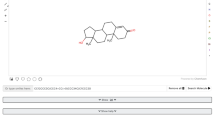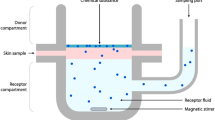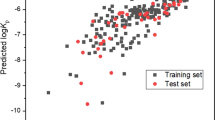Abstract
The objective of this study was to evaluate the permeation of paraben derivatives — methylparaben (MP), propylparaben (PP), and butylparaben (BP) — in hairless mouse full skin and human cadaver epidermis using a Franz diffusion cell method, which is proposed as a reliable alternative method to an skin absorption test. Parabens, esterified hydroxybenzoic acid compounds, are widely used as preservatives in food, cosmetics, and pharmaceutical products. The skin permeation rate showed dose dependency, and the hairless mouse full skin showed a higher flux value than human cadaver epidermis. Among the permeability coefficient (Kp) values of three parabens, MP showed a higher Kp value than PP or BP. Hence, according to the definitions of Marzulli et al., parabens would be classified as “moderate” penetrants.
This is a preview of subscription content, access via your institution
Access options
Subscribe to this journal
Receive 6 print issues and online access
$259.00 per year
only $43.17 per issue
Buy this article
- Purchase on Springer Link
- Instant access to full article PDF
Prices may be subject to local taxes which are calculated during checkout




Similar content being viewed by others
References
Soni MG, Taylor SL, Greenberg NA, Burdock GA . Evaluation of the health aspects of methyl paraben: a review of the published literature. Food Chem Toxicol 2002; 40: 1335–1373.
Terasaki M, Kamata R, Shiraishi F, Makino M . Evaluation of estrogenic activity of parabens and their chlorinated derivatives by using the yeast two-hybrid assay and the enzyme-linked immunosorbent assay. Environ Toxicol Chem 2009; 28: 204–208.
Giordano F, Bettini R, Donini C, Gazzaniga A, Caira MR, Zhang GG et al. Physical properties of parabens and their mixtures: solubility in water, thermal behavior, and crystal structures. J Pharm Sci 1999; 88: 1210–1216.
Andersen FA . Final amended report on the safety assessment of methylparaben, ethylparaben, propylparaben, isopropylparaben, butylparaben, isobutylparaben, and benzylparaben as used in cosmetic products. Int J Toxicol 2008; 4: 1–82.
Calafat AM, Ye X, Wong LY, Bishop AM, Needham LL . Urinary concentrations of four parabens in the U.S. population: NHANES 2005-2006. Environ Health Perspect 2010; 118: 679–685.
Elder RL . Final report on the safety assessment of methylparaben, ethylparaben, propylparaben and butylparaben. Int J Toxicol 1984; 3: 147–209.
Soni MG, Carabin IG, Burdock GA . Safety assessment of esters of p-hydroxybenzoic acid (parabens). Food Chem Toxicol 2005; 43: 985–1015.
Barr L, Metaxas G, Harbach CAJ, Savoy LA, Darbre PD . Measurement of paraben concentrations in human breast tissue at serial locations across the breast form axilla to sternum. Toxicol Appl Pharmacol 2012; 32: 219–232.
National Toxicology Program 2005 NTP Concept Document. Butylparaben. Available at URL http://ntp.niehs.nih.gov/ntp/htdocs/chem_background/exsumpdf/butylparaben_508.pdf#search=+Butylparaben.
Blair RM, Fang H, Branham WS, Hass BS, Dial SL, Moland CL et al. The estrogen receptor binding affinities of 188 natural and xenochemicals: structural diversity of ligands. Toxicol Sci 2000; 54: 138–153.
Darbre PD . Environmental oestrogens, cosmetics and breast cancer. Best Pract Res Clin Endocrinol Metab 2006; 20: 121–143.
Darbre PD, Aljarrah A, Miller WR, Coldham NG, Sauer MJ, Pope GS . Concentrations of parabens in human breast tumours. J Appl Toxicol 2004; 24: 5–13.
Darbre PD, Harvey PW . Paraben esters: review of recent studies of endocrine toxicity, absorption, esterase and human exposure, and discussion of potential human health risks. J Appl Toxicol 2008; 28: 561–578.
Golden R, Gandy J, Vollmer G . A review of the endocrine activity of parabens and implications for potential risks to human health. Crit Rev Toxicol 2005; 35: 435–458.
Harvey PW, Darbre P . Endocrine disrupters and human health: could oestrogenic chemicals in bodycare cosmetics adversely affect breast cancer incidence in women? A review of evidence and call for further research. J Appl Toxicol 2004; 24: 167–176.
Spanier AJ, Fausnight T, Camacho TF, Braun JM . The associations of triclosan and paraben exposure with allergen sensitization and wheeze in children. Allergy Asthma Proc 2014; 35: 475–481.
Towers CV, Terry PD, Lewis D, Howard B, Chambers W, Armistead C et al. Transplacental passage of antimicrobial paraben preservatives. J Expo Sci Environ Epidemiol 2015; 25: 604–607.
Panel on Food Additives and Nutrient Sources Added to Food. Opinion of the scientific panel on food additives, flavourings, processing aids and materials in contact with food on a request from the commission related to para hydroxybenzoates (E 214-219), question number EFSA-Q-2004-063. EFSA J 2004; 83: 1–26.
Han F, He YZ, Yu CZ . On-line pretreatment and determination of parabens in cosmetic products by combination of flow injection analysis, solid-phase extraction and micellar electrokinetic chromatography. Talanta 2008; 74: 1371–1377.
Hussein EI, Muret P, Berard M, Makki S, Humbert P . Assessment of principal parabens used in cosmetics after their passage through human epidermis-dermis layers (ex-vivo study). Exp Dermatol 2007; 16: 830–836.
Bando H, Mohri S, Yamashita F, Takakura Y, Hashida M . Effects of skin metabolism on percutaneous penetration of lipophilic drugs. J Pharm Sci 1997; 86: 759–761.
El Hussein S, Muret P, Berard M, Makki S, Humbert P . Assessment of principal parabens used in cosmetics after their passage through human epidermis-dermis layers (ex-vivo study). Exp Dermatol 2007; 16: 830–806.
Brain KR, Walters KA, Green DM, Brain S, Loretz LJ, Sharma RK et al. Percutaneous penetration of diethanolamine through human skin in vitro: application from cosmetic vehicles. Food Chem Toxicol 2005; 43: 681–690.
Mickelsen RL, Hall RC, Chern RT, Myers JR . Evaluation of a simple weight-loss method for determining the permeation of organic liquids through rubber films. Am Ind Hyg Assoc J 1991; 52: 445–447.
Riviere JE, Brooks JD . Predicting skin permeability from complex chemical mixtures. Toxicol Appl Pharmacol 2005; 208: 99–110.
OECD guidelines TG 428, Organization for Economic Cooperation and Development Guidance Document for the Conduct of Skin Absorption Studies OECD Series on Testing and Assessment, No. 28. OECD Publishing: Paris. 2004, 1–30.
Nishizawa C, Takeshita K, Ueda J, Nakanishi I, Suzuki KT, Ozawa T . Reaction of para-hydroxybenzoic acid esters with singlet oxygen in the presence of glutathione produces glutathione conjugates of hydroquinone, potent inducers of oxidative stress. Free Radic Res 2006; 40: 233–240.
Flynn GL, Dürrheim H, Higuchi WI . Permeation of hairless mouse skin II: membrane sectioning techniques and influence on alkanol permeabilities. J Pharm Sci 1981; 70: 52–56.
Tadeuchi H, Mano Y, Terasaka S, Sakurai T, Furuya A, Urano H et al. Usefulness of rat skin as a substitute for human skin in the in vitro skin permeation study. Exp Anim 2011; 60: 373–384.
Bartosova L, Bajgar J . Transdermal drug delivery in vitro using diffusion cells. Curr Med Chem 2012; 19: 4671–4677.
Franz TJ . On the relevance of in vitro data. J Invest Dermatol 1975; 93: 633–640.
van de Sandt JJ, van Burgsteden JA, Cage S, Carmichael PL, Dick I, Kenyon S et al. In vitro predictions of skin absorption of caffeine, testosterone, and benzoic acid: a multi-centre comparison study. Regul Toxicol Pharmacol 2004; 39: 271–281.
Venier M, Adami G, Larese F, Maina G, Renzi N . Percutaneous absorption of 5 glycol ethers through human skin in vitro. Toxicol In Vitro 2004; 18: 665–671.
Reichling J, Landvatter U, Wagner H, Kostka KH, Schaefer UF . In vitro studies on release and human skin permeation of Australian tea tree oil (TTO) from topical formulations. Eur J Pharm Biopharm 2006; 64: 222–228.
Marzulli FN, Brown DWC, Maibach HI . Techniques for studying skin penetration. Toxicol Appl Pharmacol 1969; 3: 76–83.
Baert B, Boonen J, Burvenich C, Roche N, Stillaert F, Blondeel P et al. A new discriminative criterion for the development of franz diffusion tests for transdermal pharmaceuticals. J Pharm Pharm Sci 2010; 13: 218–230.
Ng SF, Rouse JJ, Sanderson FD, Meidan V, Eccleston GM . Validation of a static franz diffusion cell system for in vitro permeation studies. AAPS PharmSci Tech 2010; 11: 1432–1441.
Wróbel A, Gregoraszczuk EŁ . Effects of single and repeated in vitro exposure of three forms of parabens, methyl-, butyl- and propylparabens on the proliferation and estradiol secretion in MCF-7 and MCF-10A cells. Pharmacol Rep 2013; 65: 484–493.
Franz TJ . Percutaneous absorption. On the relevance of in vitro data. J Invest Dermatol 1975; 64: 190–195.
Takeuchi H, Ishida M, Furuya A, Todo H, Urano H, Sugibayashi K . Influence of skin thickness on the in vitro permeabilities of drugs through sprague-dawley rat or yucatan micropig skin. Biol Pharm Bull 2012; 35: 192–202.
Netzlaff F, Kostka KH, Lehr CM, Schaefer UF . TEWL measurements as a routine method for evaluating the integrity of epidermis sheets in static Franz type diffusion cells in vitro. Limitations shown by transport data testing. Eur J Pharm Biopharm 2006; 63: 44–50.
Guth K, Schäfer-Korting M, Fabian E, Landsiedel R, van Ravenzwaay B . Suitability of skin integrity tests for dermal absorption studies in vitro. Toxicol in Vitro 2015; 29: 113–123.
Bond JR, Barry BW . Limitations of hairless mouse skin as a model for in vitro permeation studies through human skin: hydration damage. J Invest Dermatol 1988; 90: 486–489.
Caon T, Costa AC, de Oliveira MA, Micke GA, Simões CM . Evaluation of the transdermal permeation of different paraben combinations through a pig ear skin model. Int J Pharm 2010; 391: 1–6.
Cho WG . Comparison of drug delivery using hairless mouse and pig skin. J Korean Oil Chem Soc 2007; 24: 410–415.
Acknowledgements
This research was supported by grants (13162MFDS776) from Ministry of Food and Drug Safety in 2013.
Author information
Authors and Affiliations
Corresponding author
Ethics declarations
Competing interests
The authors declare no conflict of interest.
Rights and permissions
About this article
Cite this article
Seo, JE., Kim, S. & Kim, BH. In vitro skin absorption tests of three types of parabens using a Franz diffusion cell. J Expo Sci Environ Epidemiol 27, 320–325 (2017). https://doi.org/10.1038/jes.2016.33
Received:
Accepted:
Published:
Issue Date:
DOI: https://doi.org/10.1038/jes.2016.33
Keywords
This article is cited by
-
The effects of co-exposure to methyl paraben and dibutyl phthalate on cell line derived from human skin
Toxicological Research (2023)
-
Tissue Interlocking Dissolving Microneedles for Accurate and Efficient Transdermal Delivery of Biomolecules
Scientific Reports (2019)



